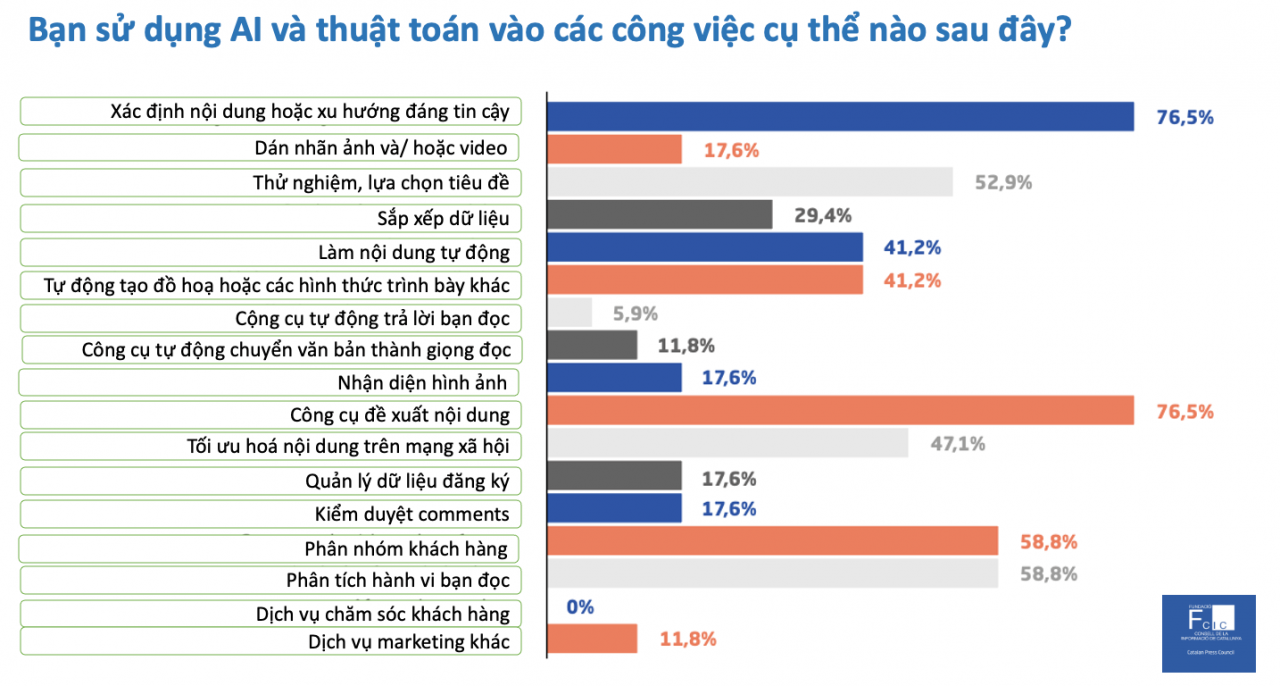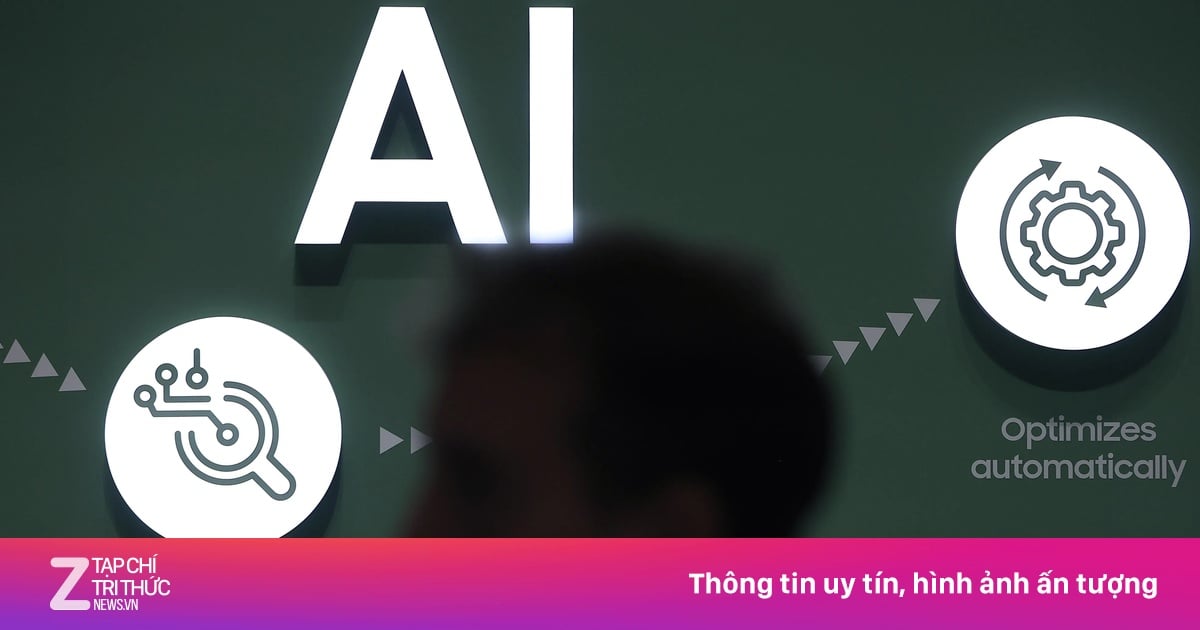Artificial Intelligence (AI) has emerged as a disruptive technology with the potential to revolutionize various industries and journalism is no exception.
 |
| While AI is revolutionizing journalism, it also raises a number of ethical and legal questions, accountability and intellectual property. (Source: Vneconomy.vn) |
In recent years, AI has played an increasingly important role in shaping the journalism landscape, from news gathering to content creation and audience engagement. AI-generated content refers to any type of content that is created by artificial intelligence rather than by humans.
This can include everything from articles and social media posts, news aggregation, text-to-speech, image generation and recognition, and even video creation….
With the ability to generate massive amounts of content in record time, AI-generated content has become a game-changer for many news organizations. But what does this trend mean for the future of journalism?
And while AI is revolutionizing journalism, allowing for faster, more accurate reporting and more personalized content, it also raises a number of ethical and legal questions around issues like accountability and intellectual property.
As AI technology continues to evolve, it is important for journalists and regulators to understand its potential as both a tool and a potential threat.
How AI helps news organizations innovate?
Save maximum cost and time
Cost and time efficiency refers to the ability of AI content creation to reduce the resources required to produce content while maintaining quality. AI can produce content at a much faster rate than humans, freeing up time and resources. AI can also create content around the clock without needing to take breaks or rest, which speeds up content turnaround times.
Furthermore, AI also helps news organizations reduce the need for editors and reporters, allowing them to invest more in other areas of operation.
The New York Times, Associated Press, Reuters and the Washington Post have used AI to create content. The Press Association (UK) can now produce 30,000 news stories per month using AI, in all forms, text, images, videos….
| RELATED NEWS | |
| Artificial Intelligence Brings Job Loss Fears, But Employees Still Want to Use AI | |
Almost absolute accuracy
Accuracy of information is a key advantage of AI, with the use of algorithms, machines are designed to follow a set of rules that ensure consistent and accurate output. Machines can process large amounts of data more efficiently than humans and they do not get tired or make mistakes due to stress. This also ensures that the output is objective and not influenced by human emotions or biases.
The accuracy of AI-generated content depends on the quality of the data used to train the AI model and the algorithms used in the creation process. AI algorithms can process huge amounts of information quickly, which can improve the accuracy of data-driven content and statistical analysis, surpassing human performance.
In the research report of the Catalan Press Commission titled: “Algorithms in the newsroom: Challenges and recommendations for artificial intelligence with journalistic ethics” the results of the investigation of press agencies applying AI in the stages of publishing their news and articles are as follows:
 |
| The results of a survey by the Catalan Press Council show the extent to which press agencies apply AI in publishing news, articles and other content production. (Source: Catalan Press Council) |
Advanced personalization and audience engagement
Artificial intelligence has the potential to change the way news is distributed and published, providing a personalized experience tailored to each reader. By analyzing user preferences, habits, browsing behavior, and social media interactions, AI algorithms can recommend relevant stories and topics of interest.
This increases audience engagement and allows journalists to create content tailored to specific audiences, increasing readership and fostering closer connections between journalists and their readers.
The challenges posed by AI for news organizations
Lack of creativity and sensitivity
One of the biggest challenges with AI-generated content is its lack of creativity and ingenuity. AI models are trained on existing data and patterns, which limits their ability to create truly original content. They are excellent at recognizing and replicating patterns and structures in their existing databases, but struggle to generate new, creative ideas.
Additionally, AI lacks the sensitivity and subtlety of a journalist, which is the ability to understand and respond to human emotions and behaviors. This means that AI-generated content may not capture the nuances of a particular situation or understand the cultural context of a piece of content, resulting in output that is potentially insensitive or inappropriate, and in some cases, even misleading.
As a result, many argue that while AI-generated content can be useful for certain tasks, it should not replace human creativity and intuition in industries like journalism. Journalists can draw on their unique perspectives and experiences to create content that is both accurate and engaging, while adapting to the changing needs and expectations of their audiences.
So, while AI is now an extremely powerful tool, surpassing journalists in some ways, it does not mean that the role of journalists in the production and distribution of newspapers should be completely eliminated. It should be used in conjunction with human expertise to create truly engaging, relevant and responsive content.
Accuracy and bias
AI-generated content can be biased or inaccurate if the algorithms are not designed properly. For example, if the training dataset is biased or the algorithm is programmed to favor certain elements, this can result in inaccurate or misleading content.
The potential for algorithmic bias and discrimination is a significant concern. Journalists and developers must work together to ensure AI systems are transparent, accountable, and built on diverse and representative datasets.
 |
| Artificial intelligence has emerged as a powerful tool in journalism. (Source: Digital.news) |
Ethical and legal issues
There are ethical and legal considerations when producing AI-generated content, as it differs from traditional journalism that relies on human judgment. AI models rely on large data sets for training, and it is important to collect and use data ethically.
Issues related to privacy, consent, and data ownership can arise when personal or sensitive information is used without consent or without appropriate safeguards. Protecting user privacy and ensuring ethical data practices are essential considerations in AI-generated content.
In some cases, AI can even be manipulated for malicious purposes, such as Deepfakes - synthetic media that convincingly alters or fabricates content, such as videos or audio recordings. Deepfakes can be used to spread misinformation, manipulate public opinion, or damage the reputation of individuals. Ethical assessments and controls are needed to combat the misuse of AI technology and develop mechanisms to verify and detect malicious incidents in order to prevent them in time.
| RELATED NEWS | |
| Artificial Intelligence and the Dangers of Modern War | |
In short, artificial intelligence has emerged as a powerful tool in journalism, transforming various aspects of the field, from news gathering to content creation and audience engagement.
While it offers unprecedented opportunities for efficiency, precision, and personalization, it also comes with ethical challenges that require careful consideration. The point is that regulators, as well as technologists and content creators, need to work together to leverage the opportunities presented by AI and responsibly address the challenges posed by AI.
Source







![[Photo] Visiting Cu Chi Tunnels - a heroic underground feat](https://vstatic.vietnam.vn/vietnam/resource/IMAGE/2025/4/8/06cb489403514b878768dd7262daba0b)


























































![[Photo] National Assembly Chairman successfully concludes official visit to Uzbekistan](https://vstatic.vietnam.vn/vietnam/resource/IMAGE/2025/4/9/8a520935176a424b87ce28aedcab6ee9)
























Comment (0)